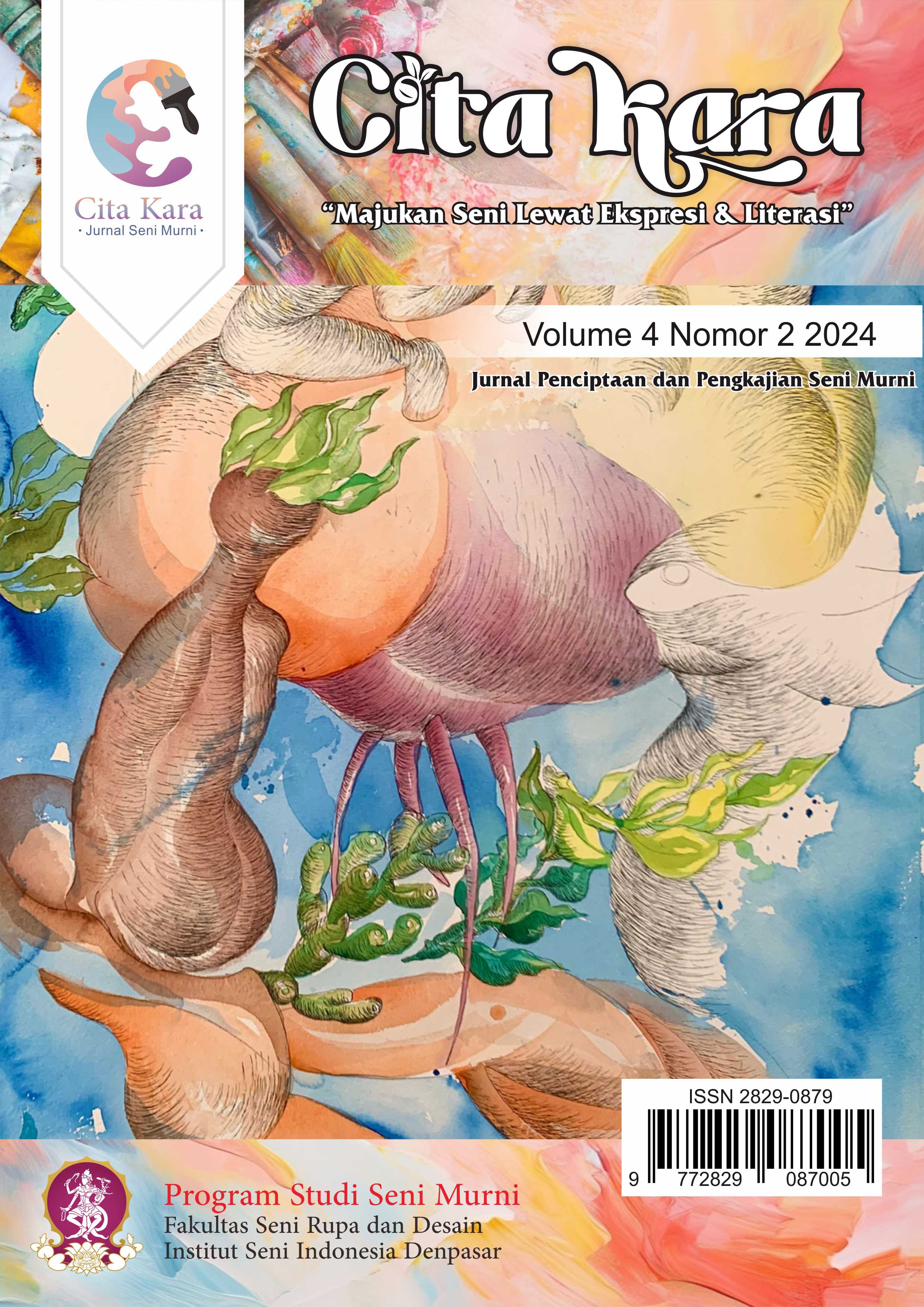Newcomers Self-Adjusment And Interpersonal Communication As An Idea For Digital Painting Art Creation
DOI:
https://doi.org/10.59997/ctkr.v4i2.3301Keywords:
Surealism, Self-Adjusment, Digital Painting, Woman FigureAbstract
The purpose of this writing is to describe the visualization process which includes: concepts, themes, techniques and forms of painting works with the title Self-Adjustment and Interpersonal Communication for Newcomers as Ideas for Creating Digital Painting Art. The methods used in creating digital painting works of art are exploration, experimentation and execution. Exploration in creating digital works of art includes research, theme exploration and model exploration, namely combining themes and concepts and determining the poses of female figures by means of observation. The experimental method was carried out to discover new things such as the use of effects in the Adobe Photoshop application and to apply ideas and notions to the creation of digital works of art by applying filters to the photo images that will be used, then continuing with experiments on combining the drawn figures. with photo images that have been edited in the Adobe Photoshop application. The execution stage is carried out by moving the sketch to a new layer. After the discussion and creative process, it can be concluded: 1.) The concept in creating digital painting works of art is to express thoughts and feelings into digital works of art by using female figures as the main objects as symbols of feelings that have meaning regarding each event that occurs. experienced by the author related to the phenomenon of adapting to a new environment and visualized with a surrealistic approach. 2.) The concept in creating digital painting works of art is to express experiences or phenomena related to interpersonal communication and self-adjustment experienced by artists in their lives. 3.) The manufacturing technique uses the Adobe Photoshop application and the IbisPaint digital drawing application and later combines photo images and figure drawings drawn manually. 4.) The form in the painting visualization displays a self-portrait painting with a surrealistic style and is inspired by the Art Nouveau art style which depicts female figures and other objects as symbols arranged by adjusting the composition so that it looks harmonious.
References
Bahari Nooryan, M.sn Dr. 2008, Kritik Seni. Pustaka Pelajar. Yogyakarta.
Crain, William. (1992). Theories of Development: Concepts and Applications. (3rd ed). (Yudi Santoso, penerjemah). Englewood Cliffs, NJ, New Jersey: Prentice-Hal, Inc.
Dewi, Ajeng, R.T.(2018). Pengaruh Keterlibatan Orangtua Terhadap Perilaku Sosial Emosional Anak. Jurnal Golden Age Hamzawadi University, 2 66-74
Dillistone,F.W. 2002. Daya Kekuatan Simbol (The Power Of Symbols).
Yogyakarta:Kanisius
Djelantik, A.A.M. 1999. Estetika Sebuah Pengantar. Bandung: Arti Line.
Gelaran Almanak Seni Rupa Jogja 1999-2009. Terbit 2009. Gelaran Budaya,
Yogyakarta.
Eco, Umberto, 1984. Semiotics and The Philosopy of Language, Mac Milan: Lon, 1976. 1976 A Theory of Semioties, Bloomington: Indiana University Press.
Fryling, Christopher. 1993. Research in Art and Design. Royal collage of Art Research Papers 1 (1): 1-5.
George Dickie, 1979, Estetika, Sixth Printing : London
Hildayani, Rini, dkk. 2015. Psikologi Perkembangan Anak. Tanggerang Selatan: Universitas
Iwan Saidi, Dr. Acep.2008.Narasi Simbolik Seni Rupa Kontemporer Indonesia.
Yogyakarta:ISACBOOK
Kaelan, H. 2012. Metode Penelitian Kualitatif Interdisipliner Bidang Sosial, Budaya, Filsafat, Seni, Agama, dan Humaniora. Yogyakarta: PARADIGMA.
Rahman, Agus, Abdul. (2017). Sejarah Psikologi: Dari Klasik Hingga Modern. Depok:Rajawali Pers.
Sachari, Agus, 2002, Estetika, Bandung: ITB
Semiun, Yustinus, (2006). Teori Kepribadian dan Teori Psikoanalitik Freud, Yogyakarta Kanisius.
Sobur, Alex. 2003, Semiotika Komunikasi, Bandung: PT. Remaja Rosdakarya
Sony Kartika, Dharsono. 2004. Seni Rupa Modern. Bandung : Rekayasa Sains.
SP, Soedarso. 1990, Tinjauan Seni, Sebuah Pengantar Untuk Apresiasi Seni. Saku
Dayar Sana. Yogyakarta.
Sumardjo, Jakob. 2000.Filsafat Seni.Bandung:ITB
Susanto, Mikke. 2002, Diksi Rupa (Kumpulan Istilah- Istilah Seni Rupa).
Kanisius. Yogyakarta.
Synnott,Anthony.2007. Tubuh Sosial (Simbolisme, Diri, dan Masyarakat).
Yogyakarta:Jalasutra
Downloads
Published
Issue
Section
License
Copyright (c) 2024 Intan Saraswati, Ni Made Purnami Utami, Tjokorda Udiana Nindhia Pemayun

This work is licensed under a Creative Commons Attribution 4.0 International License.









